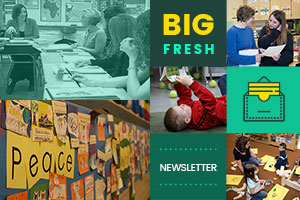Remember, if people like it here, they’ll come back.
—Ms. Fortini to Eilis in the novel Brooklyn, by Colm Tóibín
Honor and Value Students Where They Are
We’ve arrived at testing season in schools. This means many of us are holding on to hope with white knuckles.
This week’s issue is balm for my weary soul. I love our Choice Literacy community—contributors and readers—because we keep our eyes on what matters most: honoring students where they are and helping them grow a little stronger each day.
In the pressure of testing season, it is not a slight thing to honor the humanity of every child.
This week you’ll find inspiration to value and celebrate the learning process…even if students are at a different point in their learning from where someone who does not spend their days with children says they should be.
We know better. We know the beauty of growing and learning. We know the complexity of differentiating. We know the joy of meeting students exactly at their points of need.
May you know that you’re not alone in holding on to hope, and that your students are worthy and valuable, no matter their performances on a test.
This week we look at meeting students where they are—plus more, as always.
Shine on,
Ruth Ayres
Editor in Chief

The possibilities for differentiation during morning message are almost endless. Ruth Metcalfe highlights ways to meet a wide variety of needs via the morning message.
Gretchen Schroeder reminds us of the importance of checking in with students and gauging how they are feeling—and then responding with authenticity and joy.
NaPoWriMo is an excellent resource for National Poetry Month. You’ll be inspired to write with your students!
If you’re an instructional coach, we’d love for you to join our FREE coaching network, Coach-to-Coach, led by Ruth Ayres. The next meeting is Wednesday, April 23, at noon EDT.

New members-only content is added each week to the Choice Literacy website. If you’re not yet a member, click here to explore membership options.
Tammy Mulligan shares three ways to precisely differentiate small-group instruction. This is the third installment of a three-part series.
What happens when students’ reading data takes a downward trend? Dana Murphy encourages us to be confident and intensify a reading intervention with three practical moves.
Sometimes, we ask students to conform to tools that we’ve already created or have found success with when working with former groups of students. However, one size does not fit all. Melissa Quimby shows us how we can be inspired by moments of productive struggle and consider how to help a tool fit our students rather than the other way around.
Choice Numeracy | Mallory Messenger emphasizes the importance of providing time for students to share their learning and offers different formats for a share session. Mallory guides us in making decisions so that share time consolidates and uplifts the learning.
New members-only content is added each week to the Choice Literacy website. If you’re not yet a member, click here to explore membership options.
Teacher Educators Teach | Suzy Kaback shares details to help students connect with a school community. In this article full of templates and student examples, she taps the power of listening walks and empathy interviews.
Heather Fisher knows firsthand that confidence does not come easy. Here she shares three intentional actions leaders can take to build their confidence in leading professional learning.
Obstacles are a part of literacy leadership. Matt Renwick offers three steps to reframe our obstacles to reduce anxiety and stress.
Quote It:
Be confident enough in your own actions not to need to explain yourself. Trust yourself to act.
—Bernard Roth
That’s all for this week!



